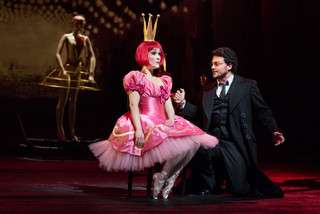|
Back
A Pallid Return for Hoffmann New York
The Metropolitan Opera
01/12/2015 - & January 16, 22, 27, 31, February 5, 2015
Jacques Offenbach: Les Contes d'Hoffmann
Vittorio Grigolo (Hoffmann), Kate Lindsey (Nicklausse), Thomas Hampson (Lindorf, Coppélius, Dr. Miracle, Dapertutto), Erin Morley (Olympia), Hibla Gerzmava (Antonia), Christine Rice (Giulietta), Tony Stevenson (Andrès, Cochenille, Frantz, Pitichinaccio), David Pittsinger (Luther, Crespel), David Crawford (a Student, Schlémil), Dennis Petersen (Nathanäel, Spalanzani), Olesya Petrova (Antonia's mother)
The Metropolitan Opera Orchestra and Chorus, Yves Abel (conductor)
Bartlett Sher (production), Michael Yeargan (sets), Catherine Zuber (costumes), James F. Ingalls (lights), Dou Dou Huang (choreographer)

E. Morley & V. Grigolo (© Marty Sohl)
Offenbach's posthumous masterpiece telling of the German Romantic poet E. T. A. Hoffmann's lost loves has returned to the Met for a short run of six performances. Bartlett Sher's production, which premiered in 2007, helped spearhead the house's initiative to bring more non-operatic directors to opera. It says little for the Met's priorities and results that this has proved one of the house's better efforts. Sher's staging, which already shows signs of age, is an eclectic mash up of styles and locales, some exotic and effective and others simply dull. Spalanzani's workshop in the Olympia act is colorful and energetic. The Antonia act is curiously set outside among boring trees. The Giulietta act does weird homage to the banal eroticism of Stanley Kubrick's film Eyes Wide Shut. Luther's tavern, where Hoffmann begins and ends the opera, is a Kafkaesque haunt of writers and students inexplicably placed in the 1920s.
If the production seems a bit unfocused, the vocal efforts on display did little to help. The most interesting were those of the young female singers cast as Hoffmann's loves. Erin Morley's Olympia screeched a bit, but captured the artificial sweetness of this doll that Hoffmann is fooled into taking for a live woman. Hibla Gerzmava credibly sang Antonia but could not displace memories of Anna Netrebko in the role when the production was new. As Giulietta, Christine Rice made the most of a part that depends more on seductive acting than dramatic musicianship. Kate Lindsey's Nicklausse rightly drew the most approbation for the mezzo's warm sonorities. Vittorio Grigolo's Hoffmann radiated some strong tenor impulses, but too often the voice came across as something other than operatic. The dramatic line lacked true power, and the sound tended to be nasally. A deeper disappointment came in venerable lyric baritone Thomas Hampson's pale delivery of the four villainous roles, each of which ruins Hoffmann's romantic projects. To a degree, all four roles share a similar set of character traits. But Hampson did little with them and instead relied on a disappointingly limited range of recycled stock gestures and outdated silent movie facial expressions. The voice, moreover, is hardly what it once was. Only traces of this singer's fine technique are there to remind us of its former splendor. Underpowered villains rarely entertain, especially with the wavering pitch that afflicted the collective parts' most important aria, Dapertutto's "Scintille diamant." It stung with embarrassment in the Antonia act to hear Hampson's Doctor Miracle outsung by David Pittsinger's more stentorian Crespel. Yves Abel led a slow performance that lacked energy.
Paul du Quenoy
|